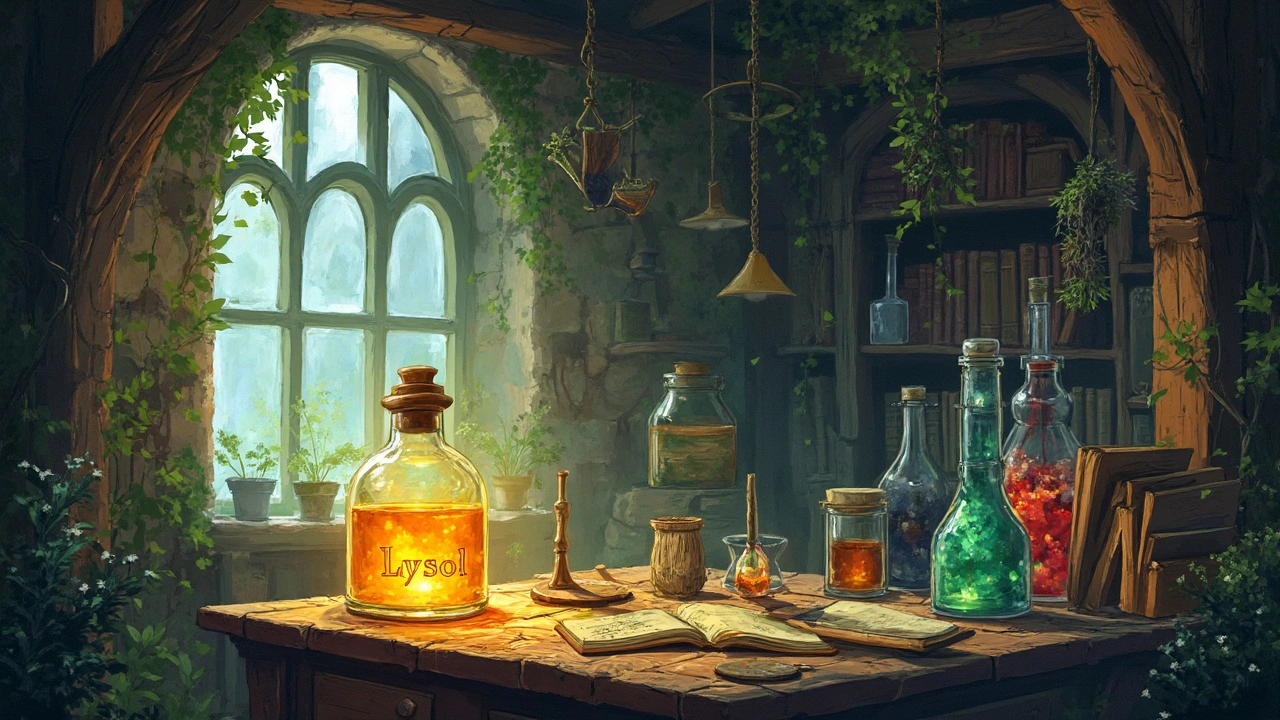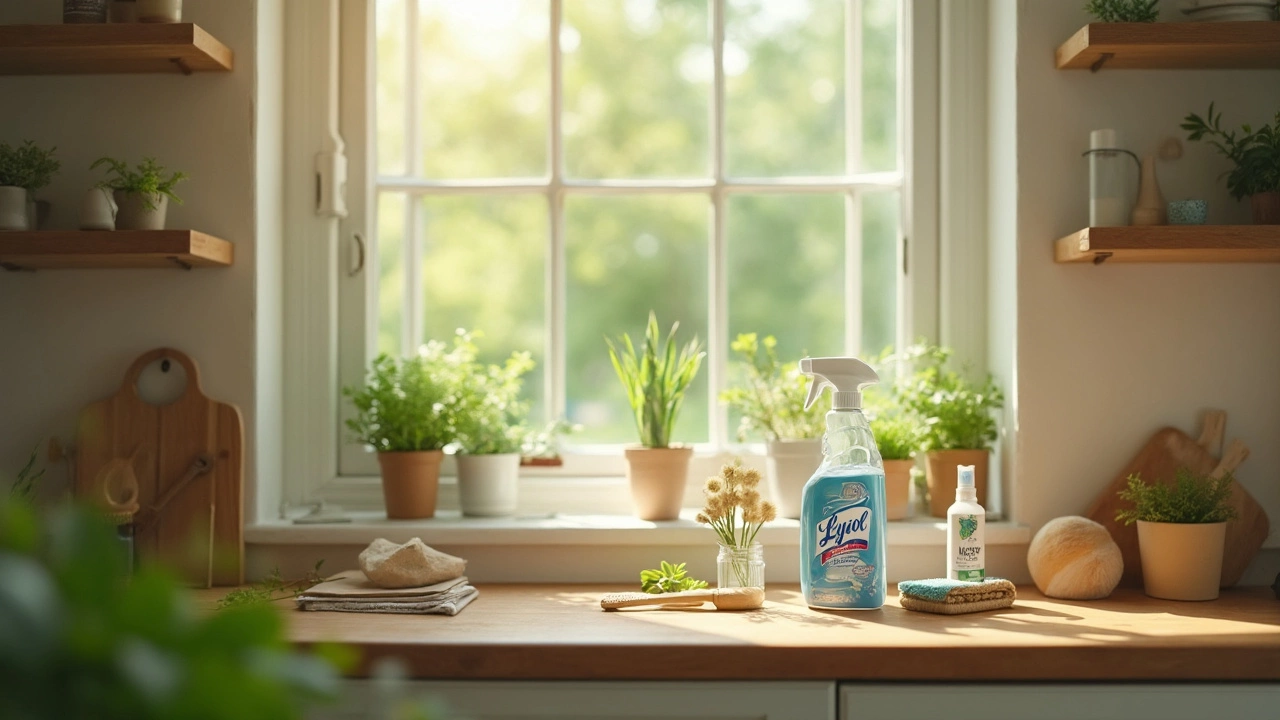When you grab that familiar yellow bottle of Lysol, you might not think twice about what’s inside. But have you ever wondered what goes into making it? Breaking it down, Lysol comprises a mix of chemicals, some of which can be quite harsh on the environment. For instance, quaternary ammonium compounds, or 'quats,' as they're called, are known for their disinfecting prowess but come at a cost to our ecosystems.
Let’s talk about the environmental impact. While Lysol excels at wiping out germs, it also leaves a trail that's not so invisible in our waterways. A lot of cleaning products contribute to water pollution, and Lysol is no exception. The chemicals can linger long after we're done cleaning, affecting aquatic life. That's why knowing what’s in your cleaning arsenal matters.
- The Ingredients Breakdown
- Impact on the Environment
- Eco-Friendly Alternatives
- Practical Green Cleaning Tips
The Ingredients Breakdown
So, what's actually in a bottle of Lysol? Ingredients are at the heart of the eco-friendliness debate. One main component is ethanol or ethyl alcohol. Now, this isn't the same stuff you sip in a cocktail, but it does a bang-up job at disinfecting surfaces. It's generally considered safe for household use, but there's a catch—it evaporates quickly, which might lead to more frequent applications.
Then we've got our classic household chemicals: fragrances and dyes. While these might make your home smell fresh, they can contribute to air quality issues inside the home. Many of these fragrances are synthetically produced and don't break down easily. This means they can linger a bit longer than you'd want.
Quats and Their Impact
Next on the list are quaternary ammonium compounds, often just called quats. They’re powerhouses for killing germs, especially the nasty ones. But here's the kicker: quats are also surfactants, which means they can stick around in water systems after you've rinsed them down the drain. And once there, they’re not super friendly to our aquatic friends.
| Ingredient | Function |
|---|---|
| Ethanol | Disinfectant |
| Quaternary Ammonium Compounds | Surfactant and Disinfectant |
| Fragrances | Scent |
| Dyes | Color |
All this ingredient talk boils down to one question: how do they affect your eco-friendly efforts? To make sure you’re walking the green path, it helps to recognize what's in the products you use and how they interact with the environment. Next time you're in the cleaning aisle, scrutinize that label and make an informed choice.
Impact on the Environment
Using Lysol is like riding a double-edged sword when it comes to the environment. On one side, it effectively tackles germs and bacteria, but on the other, its impact on nature is something we're starting to question more and more.
Waterways and Marine Life
After you spray and wipe your surfaces clean with Lysol, the remnants don't just disappear. They often make their way into our waterways. Many ingredients in these products, like those quats we mentioned, are hard for wastewater treatment plants to break down completely. This means they could end up affecting marine life, reducing reproduction rates in fish or interfering with growth in other aquatic animals.
Air Quality Concerns
Let's not forget about the air we breathe. Disinfectants can release volatile organic compounds (VOCs) into the air, which can lead to indoor air pollution. This might contribute to respiratory issues or trigger allergies. It's something to think about, especially when trying to balance cleanliness with sustainability.
Ecological Footprint
The production processes and disposal practices associated with cleaning products like Lysol also contribute to the ecological footprint. Think about the energy consumption and waste generated from these processes. Plus, the single-use nature of many disinfectant wipes adds to landfill waste.
Let's Look At Some Numbers
Here's a rough idea of what we're dealing with based on available data:
| Statistic | Value |
|---|---|
| Annual single-use wipe waste (US) | >10 billion |
| Contribution of household cleaning products to indoor VOC levels | Up to 10% |
As enticing as the quick-clean promises might be, it’s crucial to look at how our choices impact the planet. Green cleaning isn't just a trend; it's a necessity for a healthier planet.

Eco-Friendly Alternatives
If you’re looking to ditch Lysol for a greener option, you're in luck! The world of eco-friendly cleaning is bursting with alternatives that will keep your home sparkling without harming the planet.
Vinegar: The All-Purpose Wonder
Let’s kick things off with good ol’ vinegar. It’s not just for your salad dressing; vinegar is a cleaning powerhouse! It’s naturally antibacterial and works wonders on glass, mirrors, and even surfaces with grime build-up.
- Mix equal parts water and vinegar in a spray bottle for surface cleaning.
- Add lemon juice for extra zest and a fresh scent.
- For tough stains, let the solution sit for a few minutes before wiping clean.
Baking Soda: Nature’s Scrub
Next up is baking soda, which is like vinegar’s best cleaning buddy. It’s perfect for tackling tough spots and deodorizing surfaces. Got a stubborn pot that won't come clean? Fear not!
- Sprinkle baking soda directly onto surfaces and scrub with a damp sponge.
- Use it as a paste—just mix with a little water for those really grimy areas.
Castile Soap: The Versatile Cleaner
Castile soap is another gem in the eco-friendly cleaning world. This plant-based soap is gentle but effective, making it perfect for a variety of tasks, from washing dishes to mopping your floors.
- Combine with water for a basic cleaner or with vinegar for a potent disinfectant.
- A drop goes a long way—so start small!
And if you're more of a numbers person, check this out:
| Eco-Friendly Product | Price per Use | Environmental Impact Score |
|---|---|---|
| Vinegar | $0.05 | Low |
| Baking Soda | $0.03 | Low |
| Castile Soap | $0.10 | Medium |
Switching to eco-friendly cleaning might seem like a small move, but combined with others, it's like a ripple effect. Not only does it help the environment, but it also makes for a healthier home for you and your family. So next time, consider giving these natural alternatives a try!
Practical Green Cleaning Tips
Cleaning your home doesn't have to come at the environment's expense. You can make your routine more eco-friendly without compromising on cleanliness. Here are some down-to-earth tips to get you started.
1. Embrace DIY Cleaners
One of the easiest ways to go green is by making your own cleaning solutions. Simple DIY blends, like a mix of vinegar and water, can handle various messes around the house. Just add essential oils for a pleasant scent if you like. They're not only cheap but also don’t come with the harsh impacts of some commercial options.
2. Check Ingredients
When you do buy cleaners, look at the ingredient list. Steer clear of products with terms you can't pronounce or understand. Instead, go for brands committed to transparency and eco-friendliness. Check for certifications on the packaging that align with sustainable practices.
3. Use Reusable Supplies
Swap out your paper towels for cloth or microfiber alternatives. Not only will this reduce waste, but these materials are also better at trapping dirt and bacteria, making them more effective in the long run.
4. Optimize the Amount
Less is often more. Sometimes we tend to overuse products, which is wasteful and unnecessary. A little can go a long way, especially with concentrated formulas designed to clean with minimal application.
5. Support Green Brands
Eco-friendly companies are on the rise, striving to balance effective cleaning with environmental care. Supporting these brands encourages wider industry change and innovation.
6. Consider Product Lifecycle
Think about what happens to the product and its packaging after use. Opt for brands offering recyclable, compostable, or zero-waste packaging. Every small effort counts toward a sustainable solution.
It's all about making mindful choices that ease the load on our planet, while still keeping our homes fresh and clean.
